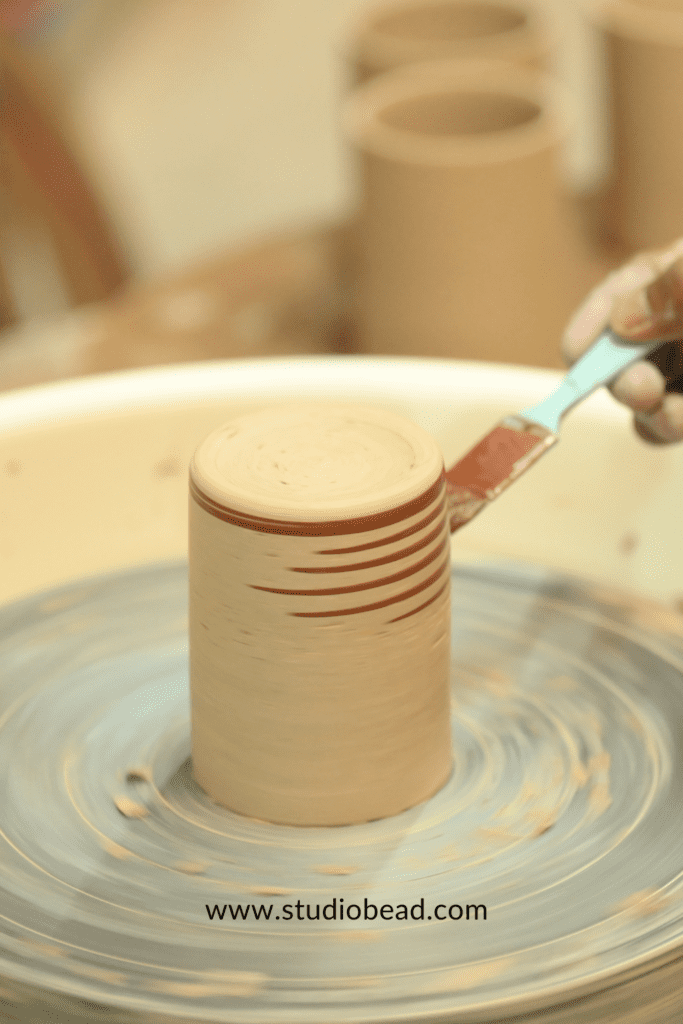Studio pottery in India has undergone a remarkable transformation throughout the years, charting a captivating evolution. Originally grounded in regional craftsmanship and traditional pottery techniques, this art form has flourished into a vibrant contemporary movement. The journey of studio pottery in India not only reflects the nation’s cultural legacy but also its openness to artistic innovation. In this exploration, we delve into the intriguing development of studio pottery, shedding light on significant milestones, influential artists, and the profound impact this art form has had on India’s creative landscape.


Historical Roots and Traditional Pottery
The history of pottery in India spans millennia, tracing its roots to ancient times. The Indus Valley Civilization, one of the world’s earliest urban civilizations, flourished around 2500 BCE and left behind remarkable examples of pottery craftsmanship. The pottery artefacts discovered from this era reveal a sophisticated understanding of clay manipulation and artistic expression.
Traditional pottery techniques, deeply ingrained in Indian culture, have been transmitted through generations. Among these techniques, the wheel-throwing method stands out as a prominent practice. Artisans skillfully shape clay on a potter’s wheel, employing a combination of hand movements and rotational force to create vessels of various sizes and forms. The use of locally sourced clay, with its distinctive properties and colours, adds an authentic touch to the pottery.
Throughout the vast expanse of India, diverse regions have developed their unique pottery styles, each marked by its own aesthetic characteristics and cultural influences. These regional variations showcase a stunning array of forms, glazes, and motifs that contribute to India’s diverse pottery heritage.
In the realm of religious and architectural art, terracotta sculptures have held a significant place in Indian culture for centuries. These sculptures, created using terracotta clay, adorned ancient temples and served as exquisite expressions of devotion and artistic excellence. With their intricate detailing and spiritual symbolism, they provide glimpses into the cultural and artistic traditions of the time.
Another notable pottery style that emerged in India is the captivating blue pottery of Jaipur. Introduced by skilled artisans from Persia in the 14th century, this technique involves a unique combination of quartz, glass, and a special type of clay. The result is a vibrant blue glaze that covers the pottery, giving it a distinctive appearance. Jaipur’s blue pottery, with its delicate floral patterns and geometric designs, has become synonymous with the city’s rich artistic heritage.
The Indralath Temple, located in Ranipur-Jharial, Odisha, is renowned as one of the tallest terracotta temples in India. This magnificent structure stands proudly on a sandstone platform, soaring to an impressive height of 80 feet. With a genesis shrouded in legends, it is believed that the temple was constructed by the deity Indra as a tribute to Lord Shiva.
The remarkable diversity and rich history of Indian pottery serve as a testament to the country’s artistic heritage.
The Revival of Studio Pottery in India
During the mid-20th century, a remarkable resurgence of interest in studio pottery swept across India, leaving an indelible mark on the country’s artistic landscape. This revival was fueled by a growing appreciation and recognition of the immense artistic value inherent in handmade ceramics. In the pursuit of artistic excellence and creativity, pioneering artists emerged as guiding lights, laying the foundation for this newfound movement.
Among these trailblazing artists were the likes of S. Kumaresan and Gurcharan Singh, whose visionary efforts played a pivotal role in rekindling the flames of studio pottery practices. With unwavering passion and dedication, they established dedicated studios and art centres that served as sanctuaries for aspiring potters and artists alike. These spaces became melting pots of ideas, fostering an environment of creativity and innovation, where artistry flourished without constraints.
Embracing the ethos of individual artistic expression, these maestros encouraged their disciples to break free from convention and explore the boundless realms of artistic possibility. The essence of studio pottery lies in the intimate connection between the artist and their craft, where each piece becomes a vessel for the potter’s thoughts and emotions, a silent testimony to their creative journey.
At the core of this artistic resurgence was an unyielding spirit of experimentation. Studio potters pushed the boundaries of traditional techniques, daring to venture into uncharted territory, and paving the way for new styles to emerge. This blend of the conventional and contemporary gave birth to a dynamic fusion, breathing new life into the age-old art form and captivating the hearts of admirers worldwide.
The creative dialogue between past and present found its expression in every swirl of clay and every brushstroke of glaze. Ancient aesthetics intertwined with modern influences, creating a harmonious dance of colours and forms that spoke of a cultural heritage preserved and reinvented.
As we celebrate the legacy of S. Kumaresan, Gurcharan Singh, and their contemporaries, we pay homage to their pioneering vision and the enduring impact they left on India’s studio pottery movement. Their unwavering commitment to preserving traditional artistry while embracing the realm of artistic experimentation continues to inspire generations of potters and artists, leaving an everlasting imprint on the world of ceramics. The mid-20th century remains a pivotal era, a renaissance of studio pottery, where artistic passion, innovation, and reverence for craftsmanship united to create a profound and enduring artistic legacy.
Contemporary Trends and Innovations
In recent decades, the landscape of studio pottery in India has undergone a fascinating transformation, as artists embrace contemporary trends and push the boundaries of artistic expression. A vibrant new generation of potters has emerged, infusing their work with fresh ideas, innovative techniques, and compelling narratives. This artistic metamorphosis has not only captured local admiration but has also garnered international attention.
One noteworthy trend that has gained prominence is the exploration of regional identities and cultural narratives through pottery. Inspired by the rich tapestry of their surroundings, these artists draw from local myths, folklore, and historical legacies to create pieces that serve as tangible reflections of India’s diverse and captivating culture. By weaving traditional motifs and techniques into their contemporary designs, these potters bridge the gap between the past and the present, keeping ancient artistry alive in a modern context.
Functional pottery has also experienced a remarkable resurgence, with a particular emphasis on tableware and home decor items. Studio potters have delved into the realm of everyday utility, transforming ordinary objects into works of art. From intricately designed dinnerware sets to elegantly crafted vases and planters, these functional pieces showcase the seamless integration of aesthetics and functionality.
Moreover, the contemporary Indian pottery scene reflects a growing concern for environmental sustainability. Artists are now incorporating eco-friendly practices and materials into their work, demonstrating a deep commitment to the planet. Organic glazes, recycled clay, and energy-efficient kilns have become essential components of their creative process, allowing them to reduce their ecological footprint and align their art with a broader global movement towards sustainability.
One such story of this transformative shift can be seen in the works of ceramist Saroj Kumar Rout and designer Julius Das. They joined the research residency under the guidance of contemporary interdisciplinary artist and BEADS mentor Jagannath Panda. During the residency, they explored and drew inspiration from the tribal Dongria Kandha of Niyamgiri, Odisha. Their work in BEADS Inaugural Edition uses stories of the tribe, traditional patterns and colours found in the local community to create breathtaking ceramic pieces. From intricately detailed mugs to stunning artworks, the work reflects both the vibrant cultural heritage of Odisha and BEADS’ own artistic vision.
Through the convergence of contemporary trends, regional influences, and eco-conscious practices, studio pottery in India has witnessed an exciting evolution. It is incredible to see how innovation and tradition have come together to breathe new life into this ancient art form! Studio pottery is now a vibrant and relevant force in our modern world, and its momentum keeps growing strong. The future of Indian studio pottery glows with a radiant promise, igniting the spark of inspiration for generations to follow. Its enduring legacy is destined to leave an indelible mark on the global stage of ceramics, fostering a profound appreciation for the artistry and cultural richness of India’s pottery tradition. The journey ahead holds the potential to captivate the world, uniting art enthusiasts from all corners and creating an everlasting impact on the beautiful world of clay.
Influential Artists and Institutions
The evolution of studio pottery in India has been shaped by the visionary contributions of numerous talented artists, each leaving an indelible mark on the art form’s growth and development. Among these influential pioneers, three names stand out: Devi Prasad, Ray Meeker, and Deborah Smith.
Devi Prasad, with his deep passion for ceramics, played a significant role in introducing innovative techniques to the Indian pottery scene. His artistic journey led him to explore traditional and contemporary styles, seamlessly blending them to create a unique expression. Through his experiments and tireless dedication, he opened up new possibilities for studio potters, inspiring them to venture beyond conventional boundaries.
Ray Meeker, a trailblazing artist, and educator, made a profound impact by establishing renowned ceramics institutions. Deborah Smith, with her visionary approach to ceramics, left an enduring legacy in India’s studio pottery community. In 1971, together they established the Golden Bridge Pottery in Puducherry, a place that became a haven for aspiring potters seeking to hone their craft. Under their guidance, students experienced an enriching environment of learning and collaboration, fostering creativity and pushing the boundaries of their artistic potential.
The Delhi Blue Pottery Trust has been instrumental in fostering the studio pottery movement in the northern region of India. Through workshops, exhibitions, and collaborative ventures, the trust has provided a dynamic platform for artists to showcase their talent, connecting them with a broader audience and fostering a thriving pottery community.
As the legacy of studio pottery continues to grow, the spirit of these pioneers will forever be etched in the artistic soul of India. Their impact transcends borders, creating a lasting influence on the global stage of ceramics and ensuring that the journey of studio pottery will continue to evolve and flourish for generations to come.
Impact on the Indian Creative Landscape
The evolution of studio pottery in India has had a profound impact on the country’s creative landscape. It has helped revive traditional craftsmanship, empowering local artisans and preserving their invaluable knowledge. Furthermore, it has provided a platform for contemporary artists to experiment, express their individuality, and connect with a global audience.
Studio pottery has also become an integral part of India’s design industry, with its unique aesthetic and functional appeal. It is not uncommon to find beautifully crafted ceramic pieces adorning modern homes, restaurants, and boutique stores.
The evolution of studio pottery in India is a fascinating journey that showcases the fusion of tradition and innovation. From its ancient roots to the contemporary landscape, studio pottery has not only preserved cultural heritage but also redefined it for modern times. The movement has nurtured talented artists, revived traditional practices, and added a distinct voice to India’s vibrant creative tapestry. As studio pottery continues to evolve, it promises to inspire future generations, bridging the gap between tradition and modernity, and enriching the world of ceramic art in India and beyond.









